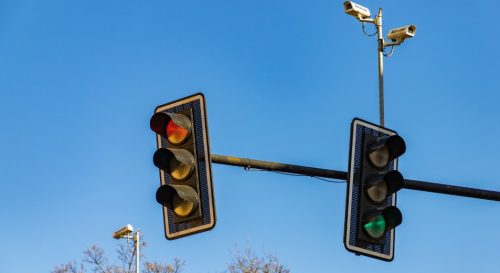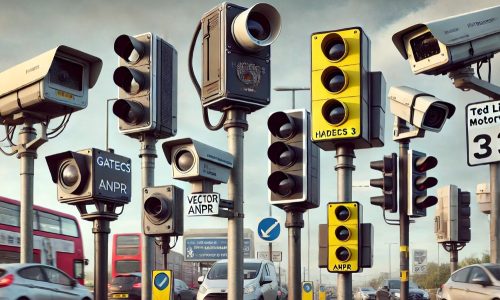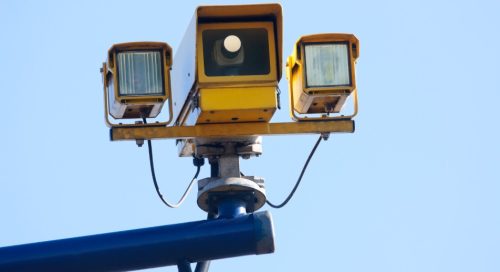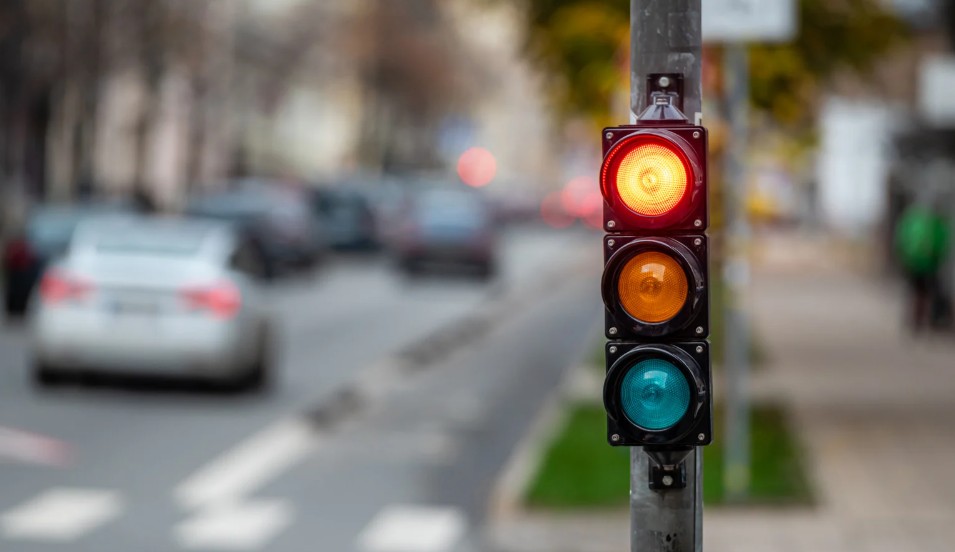Table of Contents
Traffic light cameras play a crucial role in enforcing road safety in the UK.
These cameras are designed to capture images of vehicles that pass through a red light, ensuring that drivers follow traffic rules and avoid dangerous situations at intersections.
Many drivers are unaware of what these cameras look like or how they function, leading to concerns about fines and penalty points.
Understanding the appearance, location, and working mechanisms of traffic light cameras can help drivers become more cautious on the roads.
This article provides an in-depth look at what do traffic light cameras look like in the UK, the different types, and how they differ from speed cameras.
It also covers what happens if you run a red light and how you can avoid getting caught while ensuring safe driving practices.
What Are Traffic Light Cameras?

Traffic light cameras are automated enforcement devices used to monitor vehicles at signal-controlled intersections.
They detect and capture evidence of red light violations, ensuring that drivers adhere to traffic laws. These cameras are positioned to oversee road junctions, helping reduce accidents caused by reckless driving.
These cameras work by using sensors or road markings to detect vehicles that move past the stop line when the light is red.
When a violation is detected, the camera takes high-resolution images and sometimes video footage of the vehicle. This evidence is then reviewed before a penalty notice is issued to the vehicle owner.
Traffic light cameras are crucial in preventing dangerous collisions, especially in busy urban areas. They discourage reckless driving and help maintain smooth traffic flow.
While some drivers worry about fines, these cameras primarily exist to enhance road safety and reduce the risk of accidents.
What Are the Types of Red Light Cameras in the UK?

There are several types of red light cameras in the UK, each serving a specific purpose. Understanding these types helps drivers recognize and differentiate them from other road monitoring devices.
Fixed Red Light Cameras
- These cameras are permanently installed at high-risk intersections to monitor red light violations. They are usually mounted on tall poles near traffic signals for clear visibility.
Mobile Traffic Enforcement Cameras
- Operated by police or local traffic enforcement officers, these cameras can be placed temporarily in different locations. They are often used to catch repeat offenders or monitor specific problem areas.
Infrared Red Light Cameras
- These cameras use infrared technology to capture images without a visible flash. This makes them effective in low-light conditions while reducing distractions for drivers.
Combined Red Light and Speed Cameras
- These cameras enforce both red light violations and speed limits. They can detect vehicles that speed up to avoid stopping at red lights, improving road safety.
- These cameras are strategically placed to enhance road safety and reduce the chances of collisions at busy intersections.
Do All Traffic Lights in the UK Have Cameras?
Not every traffic light in the UK has a camera. Traffic light cameras are installed at high-risk intersections where there is a history of red light violations and accidents.
Authorities decide where to place these cameras based on traffic flow, accident reports, and risk factors.
Drivers can usually identify whether a traffic light has a camera by looking for signs that indicate enforcement cameras.
Additionally, cameras are often positioned near major roads, city centres, and high-speed intersections where violations are more likely.
If a traffic light does not have a camera, it does not mean that red light violations go unnoticed.
Many areas use alternative enforcement methods, such as police patrols and surveillance cameras, to monitor road safety.
Drivers should always follow traffic rules to avoid fines and ensure safer roads for everyone.
What’s the Difference Between Traffic Light Cameras and Speed Cameras?

Traffic light cameras and speed cameras both play a role in traffic law enforcement, but they serve different purposes and are designed to monitor specific driving behaviours.
While traffic light cameras focus on red light violations, speed cameras track vehicles exceeding the speed limit.
Some dual-purpose cameras are capable of detecting both infractions, making them more versatile in road safety enforcement.
Functionality Differences
- Traffic light cameras capture vehicles that cross a red light at intersections.
- Speed cameras measure how fast a vehicle is travelling and issue fines if the speed limit is exceeded.
- Some advanced cameras can detect both red light violations and speeding offences.
Appearance and Placement
- Traffic light cameras are usually mounted on poles near intersections and junctions.
- Speed cameras are positioned along motorways, dual carriageways, and straight roads.
- Speed cameras are more visible, often in large yellow boxes, while traffic light cameras are smaller and less noticeable.
Understanding these differences helps drivers identify monitoring devices and adhere to traffic laws more effectively.
Do Traffic Light Cameras Always Flash?

Many drivers wonder whether traffic light cameras always flash when capturing violations. The answer depends on the type of camera installed at the intersection.
While some older models use a visible flash, most modern traffic light cameras are equipped with infrared technology, allowing them to operate without emitting any light.
Infrared cameras work by capturing high-resolution images in low-light conditions, making them effective even at night.
These cameras do not flash visibly, reducing distractions for drivers and ensuring smooth traffic flow.
In contrast, older models that still rely on traditional flash technology may produce a brief flash when taking a picture of an offending vehicle.
Because of this variation, drivers should not assume that a lack of flash means they have not been caught.
Many cameras operate silently and will still capture evidence even if no visible flash is seen. The safest approach is to always follow traffic signals to avoid penalties.
What Happens If You Run a Red Light in the UK?
Running a red light in the UK is considered a serious traffic offence that can result in fines, penalty points, and potential legal consequences.
The penalties are designed to encourage safe driving and reduce the risk of accidents at intersections.
The consequences of running a red light depend on the severity of the violation and whether it leads to an accident or injury.
Penalties for Running a Red Light
- A Fixed Penalty Notice (FPN) is issued, typically resulting in a £100 fine.
- The driver receives three penalty points on their driving licence.
- In severe cases, such as causing an accident, fines may increase, and drivers may be summoned to court.
Receiving a Notice of Intended Prosecution (NIP)
- A NIP is sent to the registered vehicle owner within 14 days of the offence.
- The notice includes details of the violation, location, and evidence captured by the camera.
- Failure to respond or pay the fine could lead to higher penalties or further legal action.
Ignoring red light fines can result in increased penalties, disqualification, or even court prosecution in extreme cases.
Can You Check If You’ve Been Caught by a Traffic Light Camera?

If you have been caught by a traffic light camera, you will receive a Notice of Intended Prosecution (NIP) within 14 days.
This document is sent to the registered vehicle owner and provides details of the offence, including the date, time, and location where the violation occurred.
It will also outline the fine amount and any penalty points added to the driver’s licence.
There is no official online system where drivers can check whether they have been caught before receiving the NIP.
However, if you suspect that you have been caught by a traffic light camera but have not received a notice, you can contact your local police authority or the DVLA for further information.
It is essential to respond promptly to any notices received. If you believe you were wrongly fined, you have the option to appeal the penalty by providing evidence or contesting the charge in court.
Where Are Traffic Light Cameras Usually Located in the UK?
Traffic light cameras are strategically placed at high-risk locations across the UK to enforce traffic laws and prevent accidents.
These locations are chosen based on collision history, traffic volume, and frequent red light violations.
Common Locations of Traffic Light Cameras in the UK
- Busy City Centres: High-traffic intersections in cities like London, Manchester, and Birmingham.
- Major A-Roads and Dual Carriageways: Where speeding and red-light jumping are common.
- Near Schools and Pedestrian Crossings: To protect pedestrians and schoolchildren from reckless driving.
- Motorway Junctions and Roundabouts: To monitor high-speed traffic entering controlled intersections.
- Known Accident Hotspots: Locations with frequent crashes due to red-light violations.
Authorities use data-driven analysis to decide where traffic light cameras should be installed.
While some locations have warning signs, not all do, making it essential for drivers to always follow traffic rules.
How Can You Avoid Getting Caught by a Traffic Light Camera?

The best way to avoid getting caught by a traffic light camera is to drive responsibly and obey traffic signals.
Many drivers get fined due to last-minute decisions at intersections, which can be easily prevented by following safe driving habits.
Safe Driving Tips to Avoid Red Light Fines
- Slow Down When Approaching Traffic Lights: Do not speed up when lights turn amber.
- Observe Road Signs and Markings: Some intersections have signs indicating camera enforcement.
- Avoid Distractions While Driving: Stay focused to ensure you react in time to traffic signals.
- Be Aware of Camera Locations: While not all traffic lights have cameras, many do in busy areas.
- Maintain Safe Following Distance: Helps prevent sudden stops that could lead to running a red light.
- Do Not Take Risks at Amber Lights: If you are too close, stop safely instead of accelerating.
Following these simple guidelines will help you stay safe and avoid unnecessary penalties.
Conclusion
Traffic light cameras are a key part of road safety enforcement in the UK. These cameras are designed to capture red light violations, ensuring that drivers obey traffic signals and prevent accidents.
They are placed at high-risk intersections, including city centres, busy roads, and accident-prone areas.
While not all traffic lights have cameras, those that do are strategically installed to monitor dangerous driving behaviour.
Understanding what traffic light cameras look like in the UK can help drivers stay aware and avoid penalties. Running a red light can result in fines, penalty points, and even legal consequences for repeated violations.
The best way to avoid getting caught is to follow traffic rules, drive cautiously at intersections, and stay aware of road signs. Responsible driving not only helps you avoid fines but also contributes to safer roads for everyone.
FAQs About What Do Traffic Light Cameras Look Like
Are traffic light cameras active 24/7 in the UK?
Yes, most traffic light cameras operate continuously, capturing violations at all hours. Some older models may be inactive at certain times but still serve as deterrents.
Do traffic light cameras detect drivers turning on red?
In the UK, turning on a red light is not permitted unless indicated. Traffic light cameras are designed to catch vehicles crossing the stop line at red lights.
How long does it take to receive a red light fine in the UK?
A Notice of Intended Prosecution (NIP) is usually issued within 14 days of the offence. If you do not receive one, you were likely not caught by a camera.
Can you appeal a red light camera fine in the UK?
Yes, you can appeal a red light fine if you believe it was issued unfairly. Valid reasons include faulty traffic lights, unclear signals, or emergency situations.
Do traffic light cameras work in bad weather conditions?
Yes, modern traffic light cameras use infrared technology, allowing them to capture violations in rain, fog, and low-light conditions without visibility issues.
How many points do you get for running a red light in the UK?
Running a red light in the UK usually results in three penalty points on your driving licence, along with a fixed fine of £100.
Can police access traffic light camera footage for other offences?
Yes, law enforcement can request traffic light camera footage for investigations related to accidents, hit-and-runs, or other serious offences.




